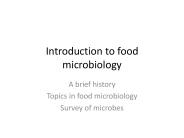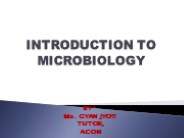Food Microbiology PowerPoint PPT Presentations
All Time
Recommended
Mechanisms of microbial spoilage of food products are studied ... Specific spoilage organisms identification. Quality Management coaching ...
| PowerPoint PPT presentation | free to view
Food safety testing market is a superset of the food testing market. Globally, the increasing high levels of fear about the food-borne diseases act as a major market driving factor for the global food safety testing market.
| PowerPoint PPT presentation | free to download
11 UNICATT Catholic University of Piacenza, Italy. 12 LFC Latvian Food Center, Latvia ... State of the Art. Broad public concern about the safety of the ...
| PowerPoint PPT presentation | free to view
Validation in food and feed microbiology: a unified approach set out by the Food ... C. De Backer, National Reference Laboratory in food microbiology ...
| PowerPoint PPT presentation | free to view
FOOD MICROBIOLOGY Presentation prepared by Mindy Brashears, Ph.D. Assistant Professor of Food Safety and HACCP * Fastidius very specific growth requirements Some ...
| PowerPoint PPT presentation | free to download
... high risk groups should avoid the food listed above and reheat and refrigerated leftovers Clostridium perfringens Problem with ... cream based desserts, ...
| PowerPoint PPT presentation | free to view
Lecture #9 Food Microbiology Conditions for Spoilage Microorganism Growth in Foods Intrinsic Factors composition pH presence and availability of water oxidation ...
| PowerPoint PPT presentation | free to view
Food Microbiology 1 Unit 3 Food borne Pathogens II Food Microbiology 1 Infection Bacteria That Cause Infection Campylobacter jejuni Salmonella Listeria monocytogenes ...
| PowerPoint PPT presentation | free to view
Food Microbiology 1 Food Groups Meat and Poultry Eggs Fish and other Seafood Milk and Dairy ... spices and sugar Emulsified then placed into casings ...
| PowerPoint PPT presentation | free to view
Food microbiology Preparing food Preserving food When microbes go wrong The fine line between fermenting and spoiling What does the microbe grow on?
| PowerPoint PPT presentation | free to download
Food Microbiology Spoilage Preservation Acidity Canning Chemical Preservation Drying Irradiation Food Poisoning Intoxication Staphylococcus aureus Enterotoxin ...
| PowerPoint PPT presentation | free to download
FOOD MICROBIOLOGY Prof. Jackson N. Ombui Department of Public Health, Pharmacology and Toxicology, University of Nairobi. (1). Inhibition principle In this principle ...
| PowerPoint PPT presentation | free to view
1. Staphylococcus aureus. has always been the most common food borne illness (Campylobacter is new) ... 2 types: Staph-like and Perfringens-like. emetic ...
| PowerPoint PPT presentation | free to view
At STS Food Testing Laboratory, we employ a rigorous and multifaceted approach to ensure the safety and quality of food products. Our testing procedures encompass a range of techniques, from meticulous sampling to comprehensive physical, chemical, microbiological, nutritional, sensory, and allergen testing. Through these thorough assessments, we strive to provide precise and reliable results, safeguarding public health and instilling confidence in the food supply chain."
| PowerPoint PPT presentation | free to download
Introduction to food microbiology A brief history Topics in food microbiology Survey of microbes People have practiced food microbiology for thousands of years ...
| PowerPoint PPT presentation | free to download
FOOD MICROBIOLOGY By ... fruits and vegetables, met, fish and dairy products. Microbiological standards and criteria. Indices of food sanitary quality.
| PowerPoint PPT presentation | free to view
900 AD 'Food Poisoning' Recognized. 1795-Appert Developed Canning ... B. C. D. A=Lag Phase. B=Log/Exponential Phase. C= Stationary Phae. D= Death Phase. Log10 cfu/g ...
| PowerPoint PPT presentation | free to view
Special Topics on Food Microbiology
| PowerPoint PPT presentation | free to view
Food Research Lab assists food manufacturers to accurately determine the use by or best before dates for products to meet stringent regulations For more information about our shelf life testings, contact FRL 1.Organoleptic Testing 2.Structural Investigation 3.Chemical Analysis 4.Ingredient Stability To Read more : https://bit.ly/3dCj7Ni To Contact us: Website: https://foodresearchlab.com/ Contact No: +91 9566299022 Email: info@foodresearchlab.com
| PowerPoint PPT presentation | free to download
Swab Test Kits ... Samplers and Swab Test Kits for Food and Beverage Applications ... by ten Cate is similar but employs plastic tubing rather than a modified syringe. ...
| PowerPoint PPT presentation | free to view
Special Topics on Food Microbiology
| PowerPoint PPT presentation | free to view
Clostridium perfringens Food Microbiology Lab Enumeration Method TSC Agar Tryptose Sulfite Cycloserine Agar Thin Pre-Poured surface and then overlay 1 m sample with ...
| PowerPoint PPT presentation | free to view
Testing Provides: Chemical Testing - Physio-Chemical Analysis Pesticide Residues Antibiotics Veterinary Drugs Contaminants & Naturally Occurring Toxic Substances Food Adulterants Food Additives Minerals & Heavy Metals Nutritional Labelling
| PowerPoint PPT presentation | free to download
Food Safety (Microbiology, Sanitation and HACCP) Frank T. Jones. Extension Poultry Specialist ... Sanitation from Greek Sanitas Health ...
| PowerPoint PPT presentation | free to view
Nicholas Appert in 1809 food preservation by canning. Pasteur was the first person to appreciate and understand the presence and role of microorganisms in food
| PowerPoint PPT presentation | free to download
MICROBIOLOGY MIMM 386 (Laboratory Course in Microbiology and ... Department of Microbiology & Immunology. McGill University. Exercise 3. Psychrophiles (9 C) ...
| PowerPoint PPT presentation | free to view
Food Innovation Lab. U.S.U. Extension Food Safety. Brian A. Nummer Ph.D. ... Utah Food Safety Managers Certification. Retail-foodservice food safety research ...
| PowerPoint PPT presentation | free to view
Food safety has become increasingly vital in the recent years with the rising food-borne malady cases. Increasing global trade activities in food business and growing client awareness have fuelled the demand for food safety testing.
| PowerPoint PPT presentation | free to download
In the 1970's a large food poisoning outbreak struck Rutgers University ... Dunkin' Donuts. The Rock. Sbarro. Douglass Caf . Rutgers Faculty Club. Brower Faculty ...
| PowerPoint PPT presentation | free to view
Food safety has become a major concern among the consumers in the recent years with rising awareness on healthy and nutritive diet. In addition, mishaps surrounding the food contamination incidents coupled with increasing awareness on the ingredients and food production has been influencing the consumer preferences towards more safe and healthy products.
| PowerPoint PPT presentation | free to download
Some of these microorganisms are used in the production of certain foods. ... Acetobacter and Gluconobacter oxidize ethanol in wine to acetic acid (vinegar) ...
| PowerPoint PPT presentation | free to view
ORGANIC VS' CONVENTIONAL FOODS: A Look at Food Safety Risks
| PowerPoint PPT presentation | free to view
iGATE Research has released a research report on “Food Safety Testing Market (by Contaminants, Pathogens, Type of Food Tested, Technology/Method, Region & Company Profile) and Forecast – Global Analysis to 2025” Click here to view the complete report: http://igateresearch.com/FullReportDetail.php?p=146 Contact US iGATE Research PVT LTD Ravi Sinha Sales Manager Marketing and Sales Divison Email: ravi.sinha@igateresearch.com Contact: +91-858-684-0791, +91-821-092-7469 (INDIA) Web: www.igateresearch.com
| PowerPoint PPT presentation | free to download
Food Irradiation. Food Safety Research Methods. Food Safety Disease Control ...
| PowerPoint PPT presentation | free to view
... Science and Technology Abstracts focused information for food scientists. Polly Catchpole. Head of Marketing & Sales. International Food Information Service ...
| PowerPoint PPT presentation | free to view
The History of Microbiology What is microbiology and how has this science come to be a specialized part of biology? Microbiology as a Science Organisms of study ...
| PowerPoint PPT presentation | free to view
S a l m o n e l l a. Advanced Food Microbiology. Ramon Bencharitiwong 471-9891. Present to ... An electron microscopy image. X-ray crystallography. Stebbins said, ...
| PowerPoint PPT presentation | free to view
... achieved, from primary production up to the delivery of foodstuffs to consumers. ... all ingredients and food additives in foodstuffs should not present: ...
| PowerPoint PPT presentation | free to view
Partnerships Produce a National Center for Home Food Preservation Research and Education Andress, E.L., Harrison, J.A, Harrison, M.A., Kerr, W.L. and Nummer, B.A.
| PowerPoint PPT presentation | free to download
Campylobacter in ready to eat foods: results of a Welsh survey Meldrum RJ * and Smith R+ (on behalf of the Welsh Food Microbiological Forum) * Food Scientist, PHLS in ...
| PowerPoint PPT presentation | free to download
Microbiology. Prokaryote Architecture. Simple in shape, but genetically and biochemically advanced. General Prokaryote Shapes. Coccus round or spherical. Bacillus
| PowerPoint PPT presentation | free to download
Microbiology Introduction and History Microbiology Introduction and History Beer Cheese Staphylococcal folliculitis Conjunctivitis Chicken pox What is Microbiology?
| PowerPoint PPT presentation | free to view
Microbiology Clinical Pathology
| PowerPoint PPT presentation | free to download
Microbiology Bacteria and Viruses Skip to last to see which sections in the book are covered in this unit!
| PowerPoint PPT presentation | free to view
Microbiology Brief Review Spontaneous Generation and Biogenesis Discovery of Microorganisms Antony van Leeuwenhoek (1632-1723) First person to observe and describe ...
| PowerPoint PPT presentation | free to view
Don t leave cooked food out too long Add food to liquid that contains all the things bacteria love (let it grow!!) ... Company: US FDA Other titles:
| PowerPoint PPT presentation | free to download
MICROBIOLOGY. From foukeffa.org. Written by Teri Micke. Ag Student Texas A&M ... FOOD MICROBIOLOGY. study of how microbes affect food. SUBSTRATE ...
| PowerPoint PPT presentation | free to view
This ppt includes introduction and history of microbiology
| PowerPoint PPT presentation | free to download
Microbiology BIOLSC 50LS-080 ... 10th ed. or 11th ed. Microbiology Lab Manual by Hsieh ... Times New Roman Arial Calibri Default Design Microbiology Introduction ...
| PowerPoint PPT presentation | free to download
Horizontal: Mother to infant Prenatal: across the placenta; HIV Perinatal: at birth, ... upset of homeostasis Microbiology Chapter 13 Epidemiology: ...
| PowerPoint PPT presentation | free to download
Date Microbiological History 1676 Leeuwenhoek discovers
| PowerPoint PPT presentation | free to view
What is microbiology? Well, it is the study of microorganisms, including bacteria, parasites, viruses, and fungi. Nostalgic much? In this article, we will go in-depth about all these terms you studied in school and more. So, as aforementioned, microbiology is all about these microbes that are entirely invisible to the naked eye but play a significant role in how we experience life.
| PowerPoint PPT presentation | free to download
Food science is a multidisciplinary field that combines the study of chemistry, biochemistry, microbiology, nutrition, and engineering to provide the scientific know-how needed to address practical problems with the diverse aspects of the food chain. We'll go over some important food science facts you should be aware of in this Pdf. Visit: https://www.nipabooks.com/info/9788119103225/innovations-in-dairy-sciences
| PowerPoint PPT presentation | free to download
Microbiology History Chapter One Microorganisms Beneficial Environment Decomposition Digestion Photosynthesis Industry Food processes Genetic Engineering Pathogenic ...
| PowerPoint PPT presentation | free to view
The area of dairy microbiology is large and diverse. The bacteria present in dairy products may cause disease or spoilage. Some bacteria may be specifically added to milk for fermentation to produce products like yogurt and cheese.
| PowerPoint PPT presentation | free to download
























































